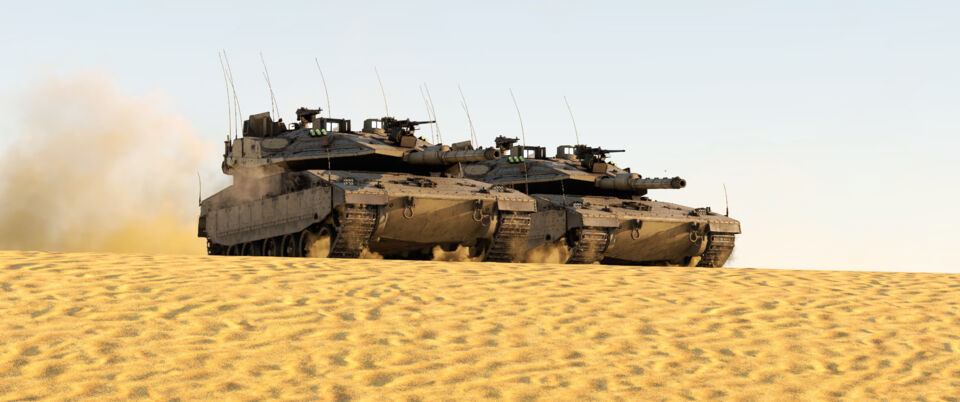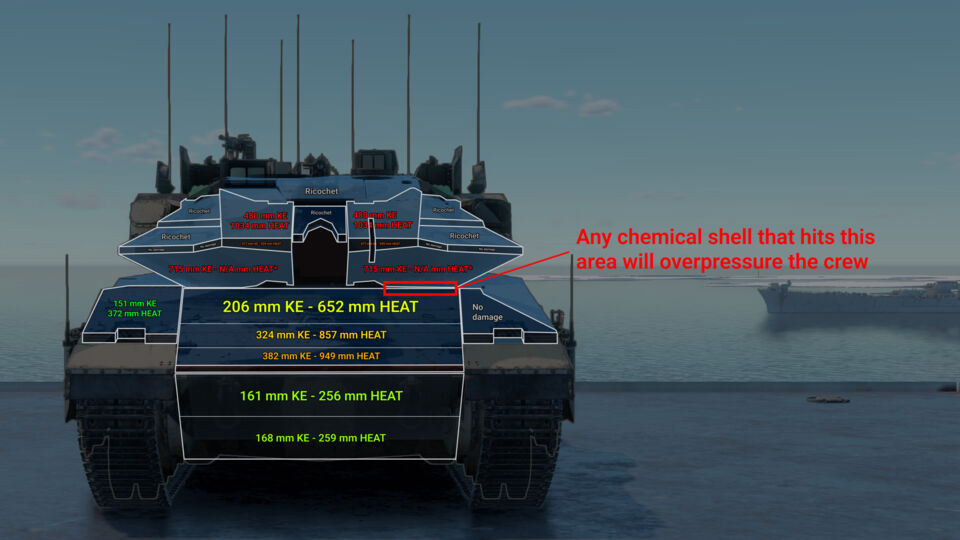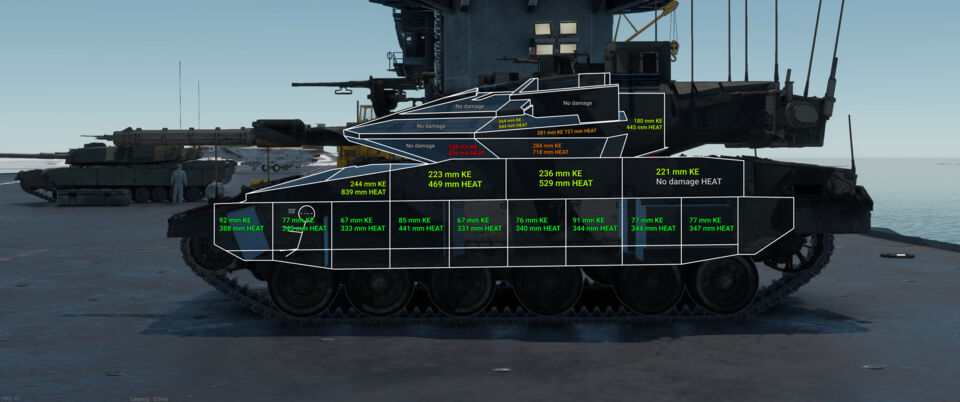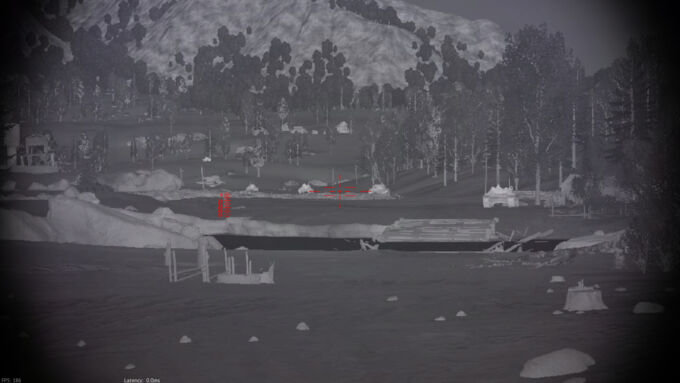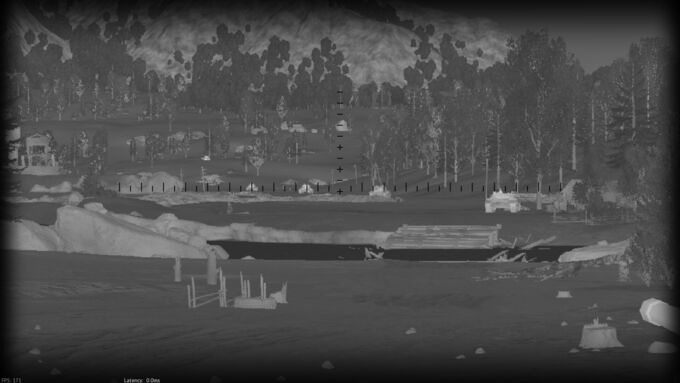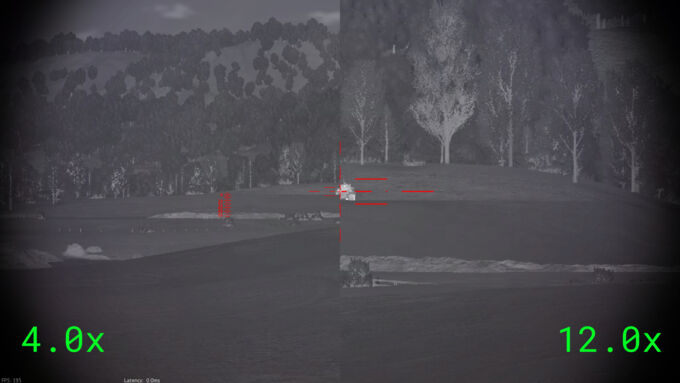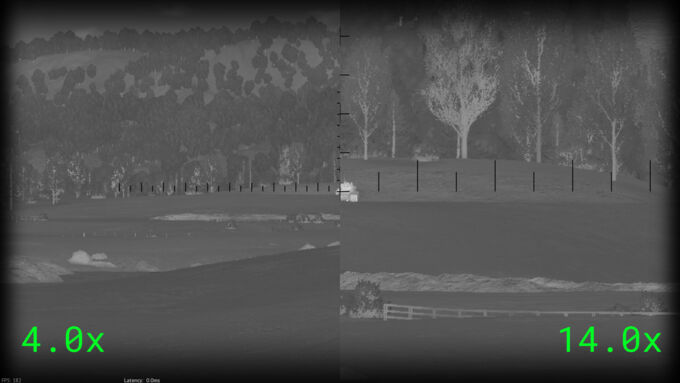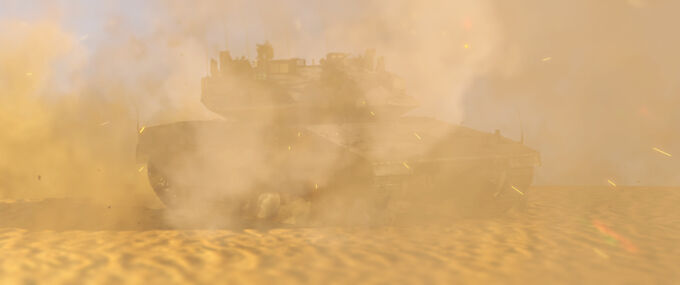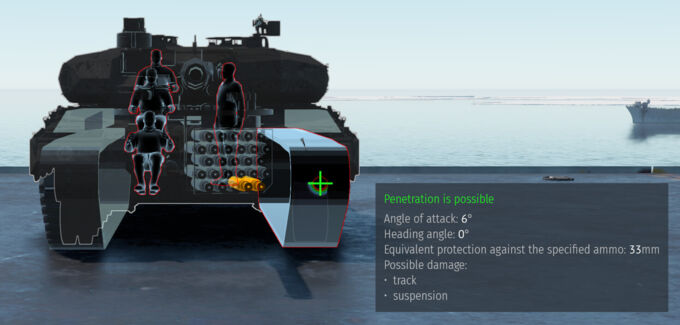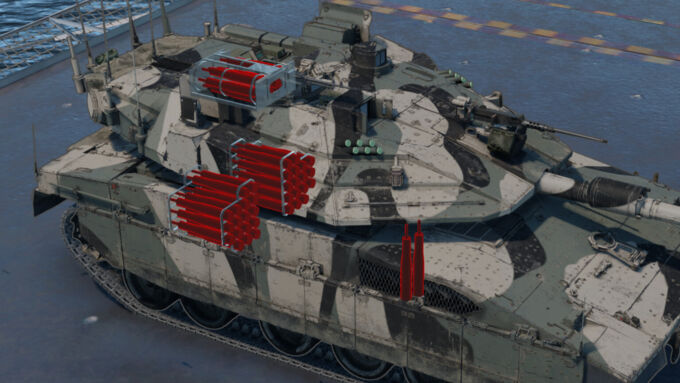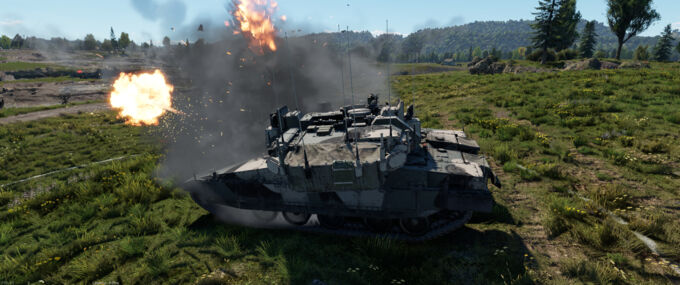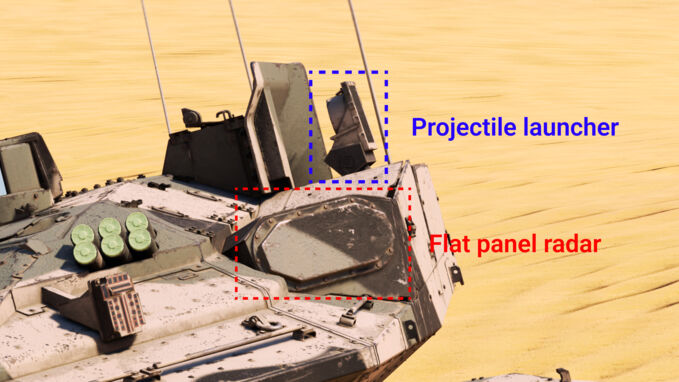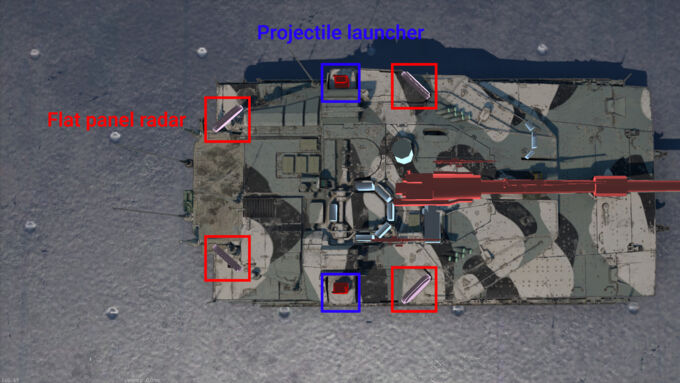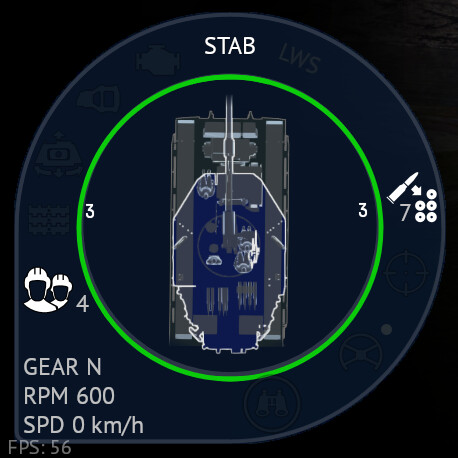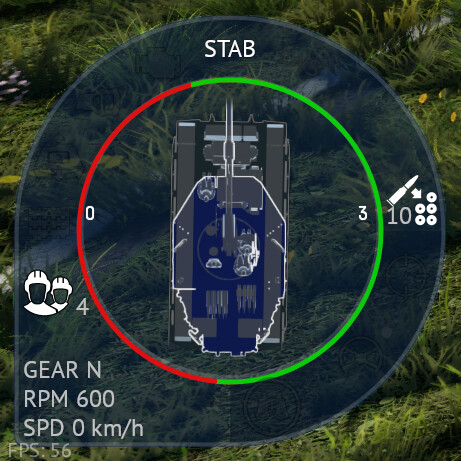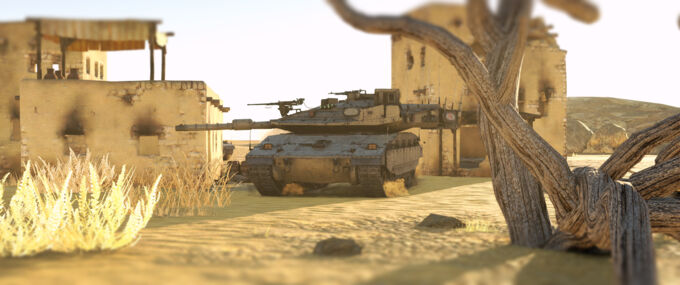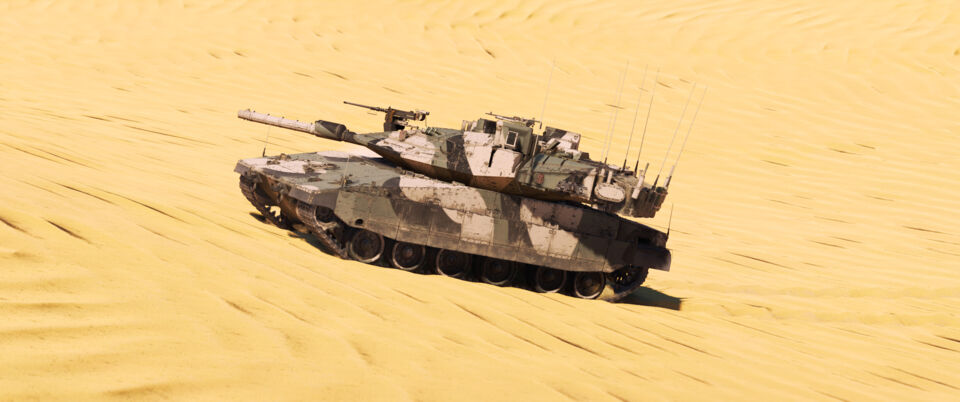The Merkava Mk.4M "Meil Ru'ach" is an Israeli indigenous MBT, designed and manufactured by Mantak and the IDF Ordinance Corps. Prioritizing crew protection and survivability over all other aspects, the tank has a frontally mounted engine to shield the crew and a well-balanced armor layout. When compared to the preceding Merkava Mk.4B/LIC, the Merkava Mk.4M is upgraded to use the venerable Trophy APS to protect the tank from ATGMs and other guided munitions. The Merkava has the potential to be a formidable weapon in the hands of a skilled player, but it demands more expertise from players to achieve success compared to other MBTs, primarily due to its weak armor.
| Pros | Cons |
|---|---|
| Powerful main gun and effective sabot round | Armor is very weak against kinetic penetrators |
| Trophy APS intercepts incoming ATGMs and some projectiles | Largest MBT in the game and a very conspicuous target |
| Good crew placement and survivability | Engine gets disabled frequently when shot |
| Excellent 64 km/h reverse speed to retreat from danger quickly | Cumbersome for close quarters combat due to the frontally mounted engine |
| Armor is effective against chemical munitions and autocannons | Slower than other MBTs due to the heavy weight and large size |
Table of contents
Relevant terms and abbreviations
| APFSDS | Armor Piercing Fin Stabilized Discarding Sabot |
| APS | Active Protection System |
| ATGM | Anti-Tank Guided Missile |
| EFP | Explosively Formed Projectile |
| ESS | Engine Smoke Screen |
| FCS | Fire Control System |
| HE-TF | High Explosive Timed Fuze |
| HEAT | High Explosive Anti Tank |
| IMI | Israeli Military Industries (company) |
| LFP | Lower Frontal Plate |
| LRF | Laser Rangefinder |
| LWS | Laser Warning System |
| MBT | Main Battle Tank |
| NERA | Non-Energetic Reactive Armor |
| RHA | Rolled Homogenous Armor |
| UFP | Upper Frontal Plate |
Protection and armor layout
Protection against KE/HEAT
The greatest weakness of the Merkava Mk.4M is its armor’s poor effectiveness against kinetic weaponry, making it an easy target to kill. Most of the tank can be easily penetrated by modern APFSDS. Combined with its very large profile, the Merkava Mk.4M is a very large and appealing target for other MBTs. Most APFSDS rounds will penetrate the UFP/LFP and the turret quite easily.
The only areas where APFSDS rounds will fail to penetrate are the angled areas of the turret which can cause ricochets. The LFP can also be considered as a deadzone because penetrating shells will not hit the crew or the FCS modules.
The Merkava Mk.4M does somewhat compensate for its lower kinetic penetration with exceptional chemical protection. Most MBT HEAT shells cannot penetrate the Merkava Mk.4M frontally and even on some areas on the sides. Only chemical munitions with over 950-1,000 mm of penetration will be able to breach the armor. The engine block is also able to effectively absorb spall from chemical munitions.
Armor layout
The Merkava has a relatively well-balanced armor layout, with composite present on nearly all of the front and some of the sides. Unlike other MBTs like the Leopard 2A7 and M1 Abrams that have thin side armor, the Merkava’s side armor is actually quite thick, with 400 mm composite blocks mounted on the upper sides and composite side skirts mounted on the lower areas. The Merkava is able to easily tank most lower-caliber autocannon rounds from the side, and withstand some higher caliber rounds like those from the 2S38 or HSTV-L for a short duration. However, the rear of the tank is still the weakest area as there is minimal armor there.
The roof armor of the Merkava is also quite strong, with the Merkava being fairly resistant against artillery strikes and being strafed from above. In real life, the Merkava Mk.4s commonly operate in tight urban environments where enemies are able to position themselves in elevated positions to target the weaker roof armor of vehicles, so the roof armor is constructed to be especially thick to resist threats from above.
Note: Although the thick composite blocks on the roof will prevent most overpressure damage, the ready rack in the turret is NOT protected by composite. Rounds that impact above the ready rack will detonate the ammo.
Internal armor
- The driver is protected by 35 mm RHA plates in the front and right side. These RHA plates also separate the engine bay from the interior of the tank.
- A 10 mm RHA plate is positioned behind the fuel tanks at the front of the tank.
- All internal ammunition except the rounds in the turret ready rack are protected by 10 mm fireproof containers.
- The rounds in the turret ready rack and the radio station are surrounded by 30 mm RHA plates.
Protection values — KE and HEAT (mm)
Survivability
Although the Merkava Mk.4M is rather resilient, its survivability is matched by other tanks like the Leopard and Abrams which also have much better armor effectiveness against KE penetrators. Tankers should not rely on the Merkava’s survivability to be successful and instead focus on not being spotted to gain the tactical advantage.
The interior of the Merkava is quite spacious, which helps to mitigate the effects of penetrating projectiles and spall damage. The frontally mounted engine will absorb penetrating autocannon rounds entirely and block some of the spall from other munitions. The Merkava Mk.4M also has a sizable amount of internal armor (see above) that helps to protect the crew from spalling. Unfortunately, the internal armor is not very effective against APFSDS and sometimes can exacerbate spalling caused by kinetic rounds. The frontally mounted engine can also prove to be more of a disadvantage rather than a benefit because penetrating shots to the UFP will destroy the engine and/or transmission and leave the tank stranded.
Survivability in different areas
From the front, most shots to the center of the UFP will destroy the engine and kill 1–2 crew. Shots to the lower areas of the UFP will destroy the engine and may injure or kill the driver as well, depending on the area of the penetration. Hits to the turret ring will usually incapacitate all of the turret crew via spall damage. From the side, most center-of-mass shots will kill the turret crew and disable the horizontal turret rotation drive. The lower side area can be considered as a deadzone, and in most cases only the loader will be killed.
Smoke grenades + ESS
Many Israeli vehicles like the Sho’t Kal Dalet and Ra’am Sagol have plenty of smoke grenades, and the Merkava Mk.4M is no exception. With 12 smoke grenades on the turret launchers available at any time, tankers can create near-instantaneous cover for retreats or for covering sightlines. After the 12 external smoke grenades have been used, smoke grenades will deploy from the internal mortar in the roof.
The Merkava also is equipped with ESS, which is similar to smoke grenades, but the smoke screen is created by injecting oil into the engine exhaust to create a cloud of smoke vapor. ESS clouds will deploy from the engine exhaust.
Note: Thermals are able to “see” through ESS smoke screens, so use the smoke grenades when needing immediate cover or when blocking sightlines.
Mobility
| Top speed | 64 km/h |
| Reverse speed | 64 km/h |
| Max horsepower from engine | 1500 hp at 2700 rpm |
| Power to Weight ratio | 22.9 hp/ton |
The 65.5-ton Merkava is powered by the General Dynamics MTU833 V12 diesel engine, which can accelerate the Merkava to a maximum speed of 64 km/h in both directions (forward/backwards). Although the Merkava is a very large tank, it is still agile enough to keep up with other MBTs, but it will be slightly slower than other MBTs like the Leopard and Abrams because of its heavy weight.
The Merkava Mk.4s also feature a reverse gearbox, which allows the tank to travel at the same maximum speed in both directions. This gives the Merkava Mk.4s the ability to retreat quickly when needed, which can be very useful.
Optics and systems
The Merkava Mk.4M has excellent optics and systems, with Generation 2 thermals, a LWS to detect laser emissions from guided weaponry, very good magnification for the gunner and commander sights, a laser rangefinder for the 120 mm cannon, and an APS system to destroy incoming threats.
Thermals
In addition to regular NVD for the driver, the Merkava Mk.4M has access to Gen 2 thermals which have an image resolution of 800×600 pixels, making them highly effective for spotting targets at long distances or in environments with dense tree cover or brush. The commander and gunner sights both have access to thermals.
Note: Ground Thermals — Thunder View has a list of all vehicles ingame that have NVD and/or thermals, with details on their imaging resolution, generation, and more.
LWS
The LWS will emit a beeping tone whenever it detects radar emissions. It is an extremely useful tool as it gives players more situational awareness, alerting them to when the vehicle is being lasered by a rangefinder or guided weaponry and providing them time to react proactively. Note that friendly laser emissions can also trigger the system.
Gunner and commander sight
The commander sight has slightly higher magnification, with an additional 2x of zoom, although the gunner sight should be sufficient in most cases.
Laser rangefinder
The laser rangefinder can be used to automatically calculate the range of the target and the compensation required for distance. The rangefinder will automatically adjust the range in the gunner/commander sights, so simply place the center of the crosshair over the target and fire.
Note: The laser rangefinder will only calculate the vertical compensation required, and not the horizontal compensation needed. Players will have to lead the target horizontally themselves if the target is moving.
Armaments
120 mm IMI MG251 cannon
The primary armament of the Merkava 4s, the IMI MG251 cannon, is a powerful 120 mm tank gun manufactured by Israeli Military Industries, or IMI. In-game, the IMI MG251 can shoot HEAT rounds, APFSDS kinetic penetrators, and high explosive shells. With aced crew skills, the crew can reload the cannon in 5 seconds with the basic crew reload taking 6.5 seconds when using shells from the ready rack in the turret.
| Ammo | 46 rounds |
| Reloading rate | 5 seconds with ace crew |
| Horizontal guidance | +/- 180° |
| Vertical guidance | -7° / +20° |
| Horizontal guidance speed | 23.8° |
| Stabilizer | 2 plane |
Ammunition choices
The Merkava Mk.4M has four types of shells available: the M322 and M338 kinetic APFSDS penetrators, the M325 HEAT shell, and the M339 HE-TF shell.
| Round | Type | Recommended usage |
| M332 | APFSDS | All ground targets |
| M338 | APFSDS | All ground targets |
| M339 | HE-TF | Light tanks, SPAA, and aircraft, some MBT weakspots |
| M325 | HEAT | Don’t carry this round (ineffective) |
M322
This is the go-to APFSDS penetrator for the IMI MG251, and the recommended round for most scenarios. M322 produces excellent spall damage, making one-shot kills likely if the round successfully penetrates. Even though this round has less max penetration than other APFSDS rounds like DM53, it still has enough penetration to go through weakspots, like turret rings and mantlets quite easily.
M338
Similar to M322, but this round has an additional 22 mm of penetration (611 mm vs 589 mm). It is still recommended to take M322 over M338 because M332 has superior post-penetration damage and is more consistent in producing spall.
M339
This is the default HE-TF round used by the 120 mm IMI MG251 on the Merkava ¾. M339 is a very effective HE shell, with 65 mm of max penetration, and it functions like a very strong SAP-HE round. HE-TF also has a time fuze, which can be set by laser rangefinding a target.
Note: The timed fuze feature is only effective against aircraft and should not be used when targeting ground vehicles. The fuze will automatically be set whenever the laser rangefinder is used with M339 in the breech, but the fuze can be manually turned off by selecting another round (APFSDS or HEAT) and then re-selecting M339 again.
The M339 round can be carried alongside the M322 APFSDS to effectively engage lightly armored vehicles such as SPAA and other light tanks. It can also be used against MBTs, provided it is aimed at overhanging roofs or other thinly armored areas.
Note: It is not recommended to use M339 against modern Russian MBTs, since they are frequently equipped with plenty of ERA which can prematurely detonate M339 before it can impact properly and overpressure the tank.
M325
M325 is the only HEAT round available on the Merkava Mk.4M. It is not recommended to take HEAT because of its ineffectiveness against composite armor and inconsistency. M322/M338 APFSDS rounds will do a much better job of penetrating enemy MBTs, while M339 is more optimal for taking out light vehicles.
Machine guns
The Merkava Mk.4M is also equipped with one 12.7 mm M2HB Browning mounted directly above the mantlet, a coaxial 7.62 mm FN MAG, and another FN MAG mounted on the roof.
The M2HB Browning is very useful for shooting down low-flying aircraft and helicopters and can also penetrate some light tanks and SPAA at close range. The two FN MAG machine guns are only useful for mowing down small obstacles like fences and bushes, or for pinging/rangefinding targets.
Ammo storage locations
There are 4 areas where ammo is stored: the ready rack in the back of the turret, two fireproof containers at the rear of the tank, and an extra space behind the engine for two rounds. The Merkava Mk.4s have very good ammo storage, and it is unlikely for a round to hit the rear ammo racks at the back of the tank.
Both of the two rear ammo racks are covered in 10 mm fireproof containers, and the ready rack is protected by internal 30 mm RHA plates. There are also two externally mounted fuel tanks behind the ammo racks which can disrupt or prematurely detonate incoming projectiles that would hit the ammo racks.
The Merkava Mk.4M can carry up to 46 rounds of 120 mm ammunition, with 20–25 rounds being the recommended limit to prevent ammo detonations.
Trophy APS
The Trophy Active Protection System (APS) was designed and is currently being manufactured by RAFAEL Advanced Defense Systems since 2010. It physically intercepts incoming projectiles that travel under 1000 m/s and destroy them with a set of EFPs before the projectile can hit the tank. The Trophy APS has a maximum of 6 countermeasures to neutralize threats. The APS system can be resupplied on friendly capture points.
The APS system will typically intercept ATGMs from ground vehicles and helicopters, and some AGMs from aircraft. There is a deadzone in areas 35° above of the tank where Trophy cannot intercept projectiles, so AGMs and GBUs launched at high altitudes may not be intercepted by the APS. The APS also has a 1.5 second delay after neutralizing a threat before it can repel another incoming threat.
| Protected sector horizontally | ±180° |
| Protected sector vertically | -15° / +35° |
| Time of readiness to re-repel threat | 1.5 seconds |
| Threat velocity | 70 — 1000 m/s |
| Count countermeasures | 6 pieces |
There are two main parts of the APS: the radar and the actual projectile launcher. The radar detects projectiles, and the projectile launcher launches the EFPs to neutralize the projectile if the radar deems it to be a threat to the tank. There are four flat-panel radars mounted on the 4 edges of the turret. The two projectile launchers are mounted on the outer area of the turret, with each containing 3 countermeasures.
When in battle, the status of the Trophy APS will be shown on the tank info section on the bottom left of the screen. The green ring indicates the protection sector, and the two numbers inside of the green ring indicate how many countermeasures the launchers have. Once the countermeasures on the launcher (s) have been used up, the ring will turn red to indicate that the launcher (s) are empty.
Note that the APS is vulnerable to damage from nearby explosions from artillery or enemy munitions. If a radar is damaged, the APS will not be able to detect threats from the sector the radar was covering. If the projectile launcher is damaged, the APS will not be able to fire countermeasures at threats. Repairing the APS is not too time consuming (repair time depends on crew skills), so make sure to repair it whenever the situation permits.
Did you know? The Namer Tsrikhon is also equipped with RAFAEL’s Trophy system. Additionally, IMI manufactures the Iron Fist APS, which is the competitor to Trophy, and it is installed on the Challenger 2 Black Knight in the British ground tree. Compared to Trophy, Iron Fist has a higher max intercept speed of 1,700 m/s allowing to intercept AFPSDS rounds but it only has 4 countermeasures, 2 less than Trophy’s max amount.
Recommended loadout
Ammo: 20x M322 APFSDS penetrators for general use, 5x M339 HE-TF shells for lightly armored targets and helicopters
Camouflage: As appropriate (avoid using the experimental tricolor or esport camos as they are very visible)
Usage in battles
The Merkava Mk.4M is highly dependent on player skill in order to perform well, and it can be a rather unforgiving experience for newer or more inexperienced tankers. In order to get the most out of the Merkava, it is paramount to familiarize oneself with map layouts and being situationally aware throughout battles. Spotting targets quickly and getting the first (accurate) shot off will usually determine whether a target is neutralized or if the Merkava is destroyed.
Due to the excellent reverse speed, the Merkava can perform quite well in a sniper role, peeking to shoot targets and then retreating quickly. Use the commander’s sight with thermals enabled to locate targets behind cover, then advance slightly to fire and quickly retreat. Wiggling the turret after or before shooting is a good practice as the angled areas of the turret can ricochet or eat shells frequently.
In urban areas, always stay alert and use thermals. The Merkava Mk.4M can sidescrape if needed, but be careful about exposing the engine around corners, as the UFP is relatively easy to penetrate. Getting immobilized should be avoided at all costs. Waiting in areas to ambush enemy tanks is also a viable strategy, as the Merkava will be able to open fire first without worrying about being shot in return.
Note: The Merkavas have very tall antennas on the back of the turret which can easily reveal the location of the tank to enemies.
The Merkava can play more aggressively against autocannon armed vehicles, and autocannon rounds will usually not be able to inflict critical damage before the Merkava gets a shot off. However, be wary of autocannons penetrating the weak LFP which can destroy the transmission and immobilize the tank.
Pay attention to LWS warnings, as the LWS will give tankers a tremendous advantage when it comes to situational awareness. A short LWS warning (2-3 seconds) is usually from an enemy rangefinder, while a continuous LWS warning is likely from a helicopter or aircraft launched laser-guided munition. Deploy smoke if needed, but the APS will be able to deal with most ATGMs and some AGMs.
Credits
Thanks to @bendawg8 from Shiryon Archive for assisting with the photography in this article.
The stats for the gun rounds, armor protection values (mm), and the Trophy APS is from ingame values.
All other work is by me, @nornfang058. The various armor diagrams were made in Figma.
